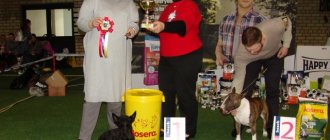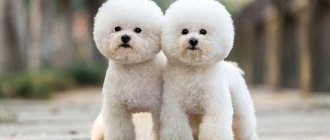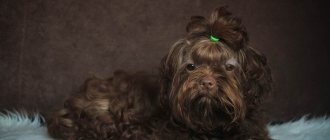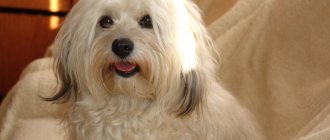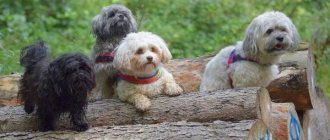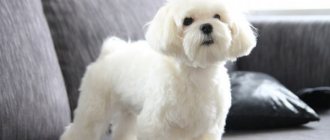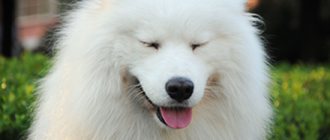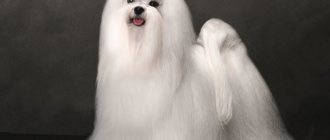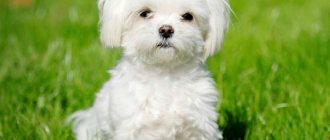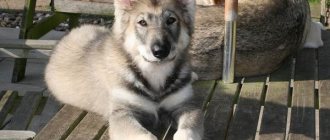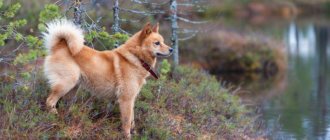A small decorative dog, bred in Russia, has a toy appearance. Despite its cute and harmless appearance, the miniature animal has a strong character, developed intelligence and good memory. The Russian colored lapdog will get along well in a family with children. She loves affection, care and attention very much, but she also requires regular care. Therefore, when purchasing a pet of this breed, the future owner must understand that at the same time he is taking on certain obligations.
Breed characteristics
| Short description | |
| Origin: | Russia |
| Conditions of detention: | House, apartment |
| Purpose: | Decorative dog, companion dog |
| Color: | Anything but white |
| Wool length: | Long |
| Adult dog size: | Height – up to 26 cm, weight – 3-4 kg |
| Average life expectancy: | 12-15 years |
| Walk: | Walking twice a day is recommended |
| Physical activity needs: | Low physical activity needs (1-1.5 hours per day of non-intensive walking) |
| Classification of the Russian Cynological Federation (RKF): | Group 9: companions and toy dogs; Section 1: Bichons and related breeds (not recognized by an international organization) |
| Puppy price: | From 5,000 to 30,000 rubles. Without pedigree - 5000-6000 rubles, pet class - 10000-12000 rubles, bril class - 15000-20000 rubles, show class - 30000 rubles |
History of the origin of the species
The history of the breed is short and not rich in historical facts. The fact is that decorative breeds were not popular in Russia until the Second World War. All dogs were useful on the farm and carried out working functions.
Since the 45-50s, when fashionistas began to be interested in Western culture, the first ladies of the USSR received rare copies of Lapdogs from abroad. The quality of further breed lines in Russia was terrible. Then it was decided to breed a new dog. The clubs were created on the basis of nurseries for hunting and service dogs.
In 1951, the first black puppy named Tim-tim was received. His parents were white and coffee lapdogs. In addition to them, Shih Tzu and Lhaso Apso took part in further selection. Puppies that matched their phenotype and color were selected.
By the end of the 50s, the line was formed. In 1999, the first breed club in Russia was created and a standard was published. Unfortunately, the Tsvetnaya lapdog has not yet received international recognition.
Price
Having such a “living toy” at home is a great happiness. But, unfortunately, in Russia you can’t buy it in every city. Therefore, if you want to become the owner of a purebred Russian lap dog, you will have to go to the capital, that is, to Moscow, to get it.
It is in this city that there are 2 kennels where such dogs are professionally bred. There, the buyer will be provided with information about the health status of each puppy and will be helped to choose one. The price of a Russian lap dog from a nursery is 20-25 thousand rubles.
If you want to save money, you can use another method of purchasing - from your own hands. The cost of a puppy of this breed from breeders for 2022 is 8-15 thousand rubles. Individuals painted black or brown are considered rare, so they can be more expensive.
Distinctive features
A small decorative dog of a stretched format, height at the withers – up to 26 cm, weight – up to 4 kg. A distinctive feature is the colored coat, while most lapdogs have white fur. Russian lapdogs are curly-haired with a thick coat, somewhat similar to small sheep.
Since the breed has not yet been accepted by international canine organizations, the standard is being written and amended in Russia. The last changes were made in 2010. All unsuitable puppies are discarded.
- The head is small, but proportional to the body, with long, thick hair. The skull is rounded, convex with a pronounced occiput and brow ridges. The stop is clearly outlined and not long.
- The muzzle is shorter than the head, not flattened, tapering towards the nose. The bridge of the nose is straight. The jaws are wide, with a scissor bite The lips are dense, thin, black.
- The nose is small, triangular, black;
- The eyes are medium in size, set wide apart, above the stop. Dark and light iris colors are allowed.
- The ears are set low, short, triangular, hang on cartilage and fit tightly to the head. Decorated with wool.
- The body is compact, rectangular. The back is long and straight. The loin is short and convex. The croup is sloping and strong. Chest of medium depth and width. The belly is tucked in. The neck is not long, but the set is high.
- The tail is not long. Throwed onto the lower back, can be twisted into a ring. Well covered with long hair.
- Limbs are parallel, set moderately wide and straight. The paws are round with pointed toes. Movements are easy.
- The coat is long, harsh, thick with a dense undercoat. The best form is large individual curls, curls.
- Colors: any colors except white.
Bolognese
Bologneses (or French lapdogs) are smart, obedient, intelligent dogs, ideal pets, devoted to their owner.
They gained particular popularity several centuries ago in the Italian city of Bologna, which is the main reason for the name of the breed.
The European nobility showed interest in them, but with the course of historical events, the popularity of the Bolognese was lost. Thanks to the efforts and perseverance of breeders, at the beginning of the 20th century the breed began to gain demand again, although at that time there were only about a dozen Bologneses left.
The breed standard was adopted in 1995. The dog's height is 20-30 cm at the withers, weight is 4.5-7 kg. The fur is white, silky, thick, covering the entire body and the high-set tail lying on the back. The furry ears are drooping, and the eyes are dark and extremely expressive. Black nose, eyelids and lips look impressive.
Bolognese is very charming and stylish. They are distrustful of strangers, but dote on their owner.
These dogs live a long time, on average 12-14 years, have excellent health and adapt to any conditions and life situations.
French lapdogs have a fairly high intelligence index for indoor dogs.
They love attention and praise. These are the most sociable dogs from the group of lapdogs.
Photo of an adult dog
Photos of puppies
Features of character and behavior
The character of Colored lapdogs can be described in one word – “family-friendly”. This dog will be happy to spend all his time surrounded by a loving, noisy family. He will give all his love and devotion to his household and will warm you with his warmth.
The breed is calm and unobtrusive, they sense the owner’s mood and will not get in the way. In addition, Lapdogs are flexible and can make friends not only with any person, but also with any pet. They have practically no downsides.
Advantages
The breed has many advantages. Owners, for the most part, do not even know what negative aspects lap dogs have. In fact, it all depends on upbringing. In general, the Russian Tsvetnaya lapdog breed was bred as an easygoing small decorative dog with a gentle character and lack of aggressiveness. In addition to these positive qualities, you can add the following advantages:
- Devotion, love, affection;
- Playfulness and energy (dogs remain active until old age);
- Lapdogs love children and people around them, treat other animals well, and even get along easily with cats;
- Dogs adapt to the rhythm of their owner’s life and sense his mood;
- Strong build (for a decorative dog, Colored lapdogs are very strong);
- Bravery and courage (they have protective instincts, they can bark at strangers, protecting their owner);
- High intelligence and ability to train;
- Cute original appearance, no shedding;
- Suitable for apartment living.
Flaws
Among the shortcomings of the breed, one can highlight only intolerance of loneliness. The dog begins to miss its owners and mope. Such pets are ready to literally follow the heels of their household members and accompany them on trips.
They can be quite naughty and spoiled, but this only occurs in the absence of upbringing. The dog's behavior always depends on the family.
Care and maintenance
The advantage of this breed is that it is easy to maintain. Lapdogs do not shed and do not emit odors. Their coarse coat does not require daily brushing. They are also not bathed as often as other decorative dogs.
Dogs can only live indoors. They feel great in urban apartment conditions because they do not take up much space. The climate does not particularly affect lapdogs. Firstly, they were bred in St. Petersburg, which is famous for its damp weather, and secondly, they have a thick coat. However, on hot days it is better to avoid direct sunlight.
Usually, owners allow lap dogs to sleep in their bed, although this is not correct in terms of upbringing. Miniature dogs can be trained to go to the indoor toilet, but walking them will be good fun.
Before buying a puppy, you need to take care of its place in the house: purchase a bed, bowls, toys, tray and hygiene products.
Nutrition
Bolonki are small dogs and do not require a lot of food. In addition, excess nutrition will lead to obesity and digestive system disorders. Feeding small breeds is usually taken much more seriously than feeding large dogs. There are a lot of prohibitions that are not recommended to be ignored:
- You should not give your dog bones, even raw and large ones;
- You cannot feed your pet from the table or encourage begging;
- Your pet does not need starchy citrus fruits and exotic vegetables and fruits (potatoes, melon, grapes, oranges, kiwi, tomatoes) in their diet;
- Flour and confectionery products are prohibited.
If the puppy was fed dry food at the kennel, then it is better to continue feeding it with food from this company. If the owner is not satisfied with the composition, then the dog can be switched to another food. This needs to be done gradually.
For Colored lap dogs, holistic (grain-free food) of super-premium class with small granules (for small breeds with average activity) is suitable. An adult dog needs 200-300 grams of food per day, diluted with water or broth.
With a natural diet, the menu must include meat (chicken, beef, rabbit, but not pork); it should occupy the bulk of the diet. In addition to it, cereals (porridge), vegetables and fruits, dairy products and eggs are mandatory.
Adult lap dogs are fed 2 times a day (morning and evening). Puppies more often - up to 2 months - 5-6 times a day, up to six months - 4 times, up to a year - 3 times.
Health
It is not yet possible to say exactly how healthy the breed is. Not only are dogs not yet recognized by a world organization, they haven't been around long enough. Perhaps the long journey of subsequent selections will change the condition of the breed. At the moment, Bolonki live about 12-14 years and do not have particularly pronounced genetic diseases.
The health of a pet most often depends on care and nutrition. If the owner follows the vaccination calendar, diet and care schedule, the dog will live a long time.
Vaccinations
All puppies, regardless of breed, must be vaccinated. This is done when maternal immunity ceases to function (1.5-2 months). Typically, nurseries take care of the first vaccination and obtain a veterinary passport. The owner must follow the vaccination schedule:
- Vaccine against infectious diseases (enteritis, plague, influenza, etc.) at 1.5-2 months, repeated after 2 weeks, at 6 months, at 12 months and annually;
- Rabies vaccine at 7 months and annually.
Even if the dog is an indoor dog and does not go for walks, vaccination is necessary. A person is capable of carrying millions of living organisms, including viruses, on clothes and shoes. To protect the puppy, it is important to carry out vaccinations on time and follow some rules.
The dog must be absolutely healthy. All vaccinations are carried out by experienced specialists; in case of an allergic reaction, they are able to save the animal. Before the procedure (two weeks), the pet is dewormed using medications. After each vaccination, it is necessary to maintain a two-week quarantine to develop immunity.
Puppies and pregnant bitches are most susceptible to infectious diseases. Such pets should not be introduced to dogs, because the risk of contracting the virus is high. Even vaccinated pets are not completely protected from infection.
Diseases
Colored lapdogs are a new breed line, the health of which is still difficult to judge. So far, there are not even breed-specific diseases to which these particular dogs are susceptible. It can be predicted that due to their small size, lap dogs will develop diseases of the joints and muscles.
Like all small breeds, they can develop digestive problems. In addition, they are susceptible to severe tearing and conjunctivitis. Breeders mention tartar and gum disease.
One way or another, most diseases appear due to improper care and lack of necessary vaccinations.
Walk
Although these dogs are intended for apartment living, they need walking just like other pets. Twice daily walks of 20-40 minutes are suitable. Lapses enjoy the company of pets and people, so playing outdoors with other animals will be good fun.
Puppies begin to be walked after the second vaccination. Small dogs should be accustomed to regular outdoor toileting and a leash. The pet must know its name and the voice of its owner, only then will it be able to walk freely.
Lapdogs show good results in agility, so you can take them to dog parks where there are special obstacles. In dirty and cold weather, dogs are dressed in protective overalls and raincoats.
Grooming
Lapdogs have long, thick, curly hair, the condition of which needs to be monitored.
- They do not shed, so you need to comb them 3-4 times a week, removing tangles and knots. You can pick up a brush at any pet store, preferably with long metal teeth.
- In the summer, animals are cut ; the standard does not provide for grooming, but for the convenience of the dog and the owner, this can be done.
- They are bathed 2 times a month with special shampoos for long-haired dogs. If the dog gets dirty, you can rinse it in warm water.
- Paws are washed after every walk. Drying wool is required.
- To the eyes from watering, the fur on the forehead is tied into a ponytail. Wipe mucous membranes daily.
- The ears are examined a couple of times a week.
- Teeth are brushed with a special paste or cords 2-3 times a month. Nails are trimmed and filed as they grow.
During the summer and spring periods, the dog must be treated for fleas and ticks. Don't forget about deworming medications.
Nutrition
It makes no sense to say that nutrition plays almost the leading role in the formation of canine immunity. Breeders at offline meetings and on the Internet loudly argue among themselves which is better - factory feed or natural products.
Black Russian lapdog puppies
And the owner and his pet solve this issue quietly and peacefully in their kitchen. In the end, this is a purely individual matter. Is it convenient for the owner to feed the dog dry food? Great. The main thing is to ensure that the food is of high quality, and also measure doses in accordance with the standards prescribed on the packaging. Vitamins and minerals are already included in the diet, so there is no need to worry about it further. In addition, the packaging is convenient to take on trips.
Do you have enough time for daily cooking? Also a great option, although more troublesome. But there will always be variety in the bowl. The dog will happily eat meat, sea fish, vegetables, fruits, cereals, and sour milk. The lapdog especially reveres quail eggs.
In both cases, it is important to provide the dog with drinking water by placing the bowl in a place accessible to the animal. Any owner of the breed should know that Russian lapdog puppies eat up to six times the first three months, and then one feeding is removed every month. By the age of one year, the dog eats twice a day, but does not remain hungry, because the amount of food in the plate has gradually increased.
The general rule for all breeders is not to feed the dog from your table, despite its sad and sad look. You should not give sweets, smoked foods, salty foods, potatoes, legumes, as well as foods that lead to gas formation.
Mating
Official mating must take place under the patronage of a nursery . To do this, dog owners sign and fill out a special form indicating the date. Both pets are checked and disinfected. The owner of the dog sets the price. Usually it is equal to one puppy or a percentage of the cost of the dog. If the female does not become pregnant, mating is not paid.
Bolonki become sexually mature at 10 months, but the most favorable period for mating is 2 years. During heat, the girl should show some signs indicating readiness: loosening and softening of the loop, clear discharge and playful behavior.
The female is brought to the male dog’s territory so that the boy feels confident and knows that this act is carried out only in his home . The animals sniff and get to know each other. After which the girl will allow you to do the cage. If there is no lock, there is no need to worry, this does not mean that the female is empty. Repeated fastening is carried out after 48 hours.
Vaccinations for Russian colored lapdogs
Vaccination is carried out against the following diseases:
- canine distemper or distemper;
- parvovirus enteritis - the causative agent is parvovirus;
- infectious hepatitis - causative agent hepadnavirus;
- parainfluenza;
- rabies;
- leptospirosis;
- coronavirus;
- trichophytosis.
When should a puppy have his first vaccination?
- At 2 months the first vaccination is carried out. After the injection, the puppy should not be washed, overfed or taken outside. Immunity after the first vaccine is developed within 12 days; this period becomes the most dangerous for the baby. A person needs to make a lot of effort to alleviate the puppy’s condition. After the first vaccination, puppies experience increased body temperature, general weakness and diarrhea.
- After 3 weeks, the puppy is given a second vaccination, but with the same vaccine. As a rule, after the second vaccination the dog feels much better, but for 12 days it must be protected from other animals, from drafts and not taken out for walks. After this time, walks are allowed.
- At 6 months of age, the puppy is vaccinated against rabies and a complex vaccine against several diseases. It is forbidden to vaccinate if the dog's teeth are changing. You need to wait until all the teeth are replaced, and then vaccinate the baby.
- At one year of age, the dog is given a comprehensive vaccine.
- Further, once a year the dog should be vaccinated with the same complex vaccine.
How to vaccinate a puppy?
Only a qualified specialist should vaccinate a puppy .
Before vaccination, he must examine the dog, measure its body temperature, and only if everything is normal, give the injection. The vaccine is placed either in the scruff of the neck or in the hip of the dog. The entire list of vaccinations administered by the veterinarian must be recorded in the dog’s passport. It also indicates the date of vaccination; subsequently, the owner himself will know the expected date of the next vaccination.
Key points in training
These dogs are very smart and easy to educate and train. Unlike Yorkshire Terriers, they are not prone to dominance and manipulation of their owner. But you still need to raise a puppy, showing that the person in the house is in charge . Rough methods must be eliminated. A motivational training session or game is best.
Although this breed is miniature, it should not be allowed to sleep or jump on human furniture. Also, the pet should eat only after the whole family. Begging is stopped and punished.
Colored lap dogs cope well with agility and perform in various competitive programs. They enjoy training with their owner. By 4 months, the puppy should learn its name. From now on you can start learning basic commands.
Read about how to properly train a dog in the article: “Training a puppy: effective methods from dog handlers, learning commands at home.”
Beagle
"Beagle"
Dogs of the Beagle breed appeared in medieval England. The royal nobility used them to track deer and roe deer and hunt hares. This breed of small dogs instantly captivates with its remarkable charm, and their charming eyes seem to look straight into your soul, especially if the animal has set the goal of begging you for a treat. These dogs have a short and dense coat, standard height at the withers varies between 33-40 cm and a weight of 9-14 kg. Beagles have an excellent temperament - they are energetic and intelligent, playful, loyal and friendly. Their keen sense of smell can sometimes make walks especially interesting as they try to keep track of every scent they encounter.
How to choose a puppy
The Russian colored lapdog is not recognized by the international cynological organization, so purchasing a puppy is not an easy task. There are not many official nurseries in Russia that breed the breed. Buying a puppy from a private person does not always guarantee the health of the pet, but it may be cheaper.
- The breeder must provide all the necessary documents and tell the future owners everything about the breed line and the dog’s parents. He has the right to refuse a sale if he believes that people will not be able to care for the animal.
- Before purchasing, owners must decide on the gender and class of the dog . Bitches are more flexible and can bear offspring, males are more active and playful. If the pet is purchased as a pet, then a pet-class puppy is suitable, but if for exhibitions, then a show-class puppy.
- Healthy dogs will be active and inquisitive. The one who pays attention to the people who come first, as a rule, becomes the most devoted friend. The cost of lap dogs depends on their class and varies from 5,000 to 30,000 rubles.
A dog, even one as small as a Russian Tsvetnaya lapdog, is a big responsibility. The decision to purchase should be made by the whole family. This dog will be able to give all his love and devotion, but will require a lot of attention in return.
5 / 5 ( 2 voices)
Estrus in Russian colored lapdogs
What should a bitch owner know?
- age of onset of the first estrus in a female dog is 6-12 months;
- duration of estrus is 20-22 days, sometimes up to a month;
- frequency of estrus – 1-2 times a year with an interval of 6-9 months;
- signs of estrus – swelling of the dog’s external genitalia, spotting;
- frequent urination - having to walk more often than usual;
- psychological signs - a change in the dog’s behavior - from aggressive to lethargic;
- perhaps there is a change in appetite and the dog drinks more water;
- often bitches begin to shed before going into heat;
- lick the loop intensively.
How to notice the onset of heat?
You can notice the approach of estrus while walking your dog. Behavior can change, often the dog becomes active, playful and disobedient, or, on the contrary, looks unhappy and lethargic. The bitch makes frequent marks - scent “lures” for male dogs, and urination occurs more frequently. The loop becomes more and more swollen; when pressed, you can see a discharge of light pink or dull pink color. If you notice changes in the dog's behavior, do not be lazy and check the dog every day for the onset of heat by dabbing the bitch's loop with a napkin or toilet paper. Pinkish discharge will be the beginning of estrus - mark this day in your dog’s notebook.
The course of the dog's first heat.
- The first heat in dogs is not the same as the next one.
- It may be shorter or longer than the usual estrus period.
- The bitch has either only weak manifestations of estrus, or, conversely, very heavy discharge.
- The first heat may suddenly stop, and then after some time begin again.
- There may be mucous discharge from the loop, a smell that attracts males, and the estrus itself will begin after some time.
- Try not to miss the start time of the first, and subsequently the second estrus, in order to correctly determine the intervals between estrus and know their timing and duration.
Precautions during estrus.
If you are not interested in getting puppies from a dog, you need to take precautions during heat:
- walk your dog ONLY on a leash: even the most obedient dog these days can simply run away, not paying attention to commands;
- do not allow male dogs to mount the dog: if sexual intercourse begins, it is almost impossible to separate them;
- during a walk, literally DO NOT take your eyes off the dog, even when buying bread in a tent, eliminate or minimize contact with male dogs;
- there is a danger of the dog catching a cold in the cold season, the best way to protect yourself is not to walk for a very long time in cold weather and use dog clothes;
- If your dog lives freely on your territory, then from the moment the estrus begins, lock the dog in an enclosure.
